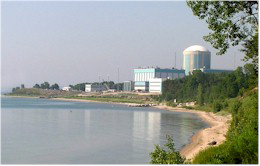 NRC file photo of Kewaunee atomic reactor on Lake Michigan in WIFrom The Washington Post: "Dominion Resources Inc. said Monday that it plans to close and decommission its Kewaunee Power Station in Wisconsin after it was unable to find a buyer for the nuclear power plant".
NRC file photo of Kewaunee atomic reactor on Lake Michigan in WIFrom The Washington Post: "Dominion Resources Inc. said Monday that it plans to close and decommission its Kewaunee Power Station in Wisconsin after it was unable to find a buyer for the nuclear power plant".
As nuclear power continues to crumble under the weight of its own disastrous economics, Dominion CEO, Thomas F. Farrell II, becomes the latest industry CEO to lose confidence in the nuclear business. "This decision was based purely on economics," Farrell said. Dominion also operates the two North Anna, VA reactors, where a proposed third reactor plan looks fragile at best. It also operates Millstone, CT and Surry, VA.
A buyer could not be found, even though the U.S. Nuclear Regulatory Commission (NRC) had already rubberstamped a 20 year license extension at Kewaunee.
Reuters also reported on this story, stating that more atomic reactors could follow suit, their bad economics forcing their closure:
"Especially vulnerable under this scenario would be small, old single reactor sites.
Other units that could be on the hit list because they fit the profile include Exelon Corp's Oyster Creek in New Jersey, Xcel Energy Inc's Monticello in Minnesota, and Entergy Corp's Palisades in Michigan, Vermont Yankee in Vermont and Pilgrim in Massachusetts."
In the past 15 years, nearly half of the atomic reactors operating on Lake Michigan's shores have closed. In 1997, Big Rock Point in Michigan was permanently closed, as were Zion 1 & 2 in Illinois in 1998. Kewaunee's closure in 2013 will be the fifth reactor shut down on Lake Michigan's shores in 15 years. This will leave Point Beach 1 & 2 in WI, Palisades in MI, and Cook 1 & 2 in MI still operating on Lake Michigan's shores. Lake Michigan is a headwaters for the Great Lakes, 20% of the world's surface fresh water, providing drinking water for 40 million people in 8 U.S. states, 2 Canadian provinces, and a large number of Native American First Americans.
Several years ago, Kewaunee had more NRC "yellow findings" (the second highest category of safety violation) than the other (at the time) 102 operating reactors in the entire country. The very same year, Point Beach had more "red findings" (NRC's worst category of safety violation) than the rest of the industry combined. Kewaunee and Point Beach are a mere seven miles apart, the same distance as between Fukushima Daiichi and Daini in Japan. Daiichi and Daini's proximity, as well as their proximity to Tokai nearer Tokyo, led the Japanese federal government to prepare worst case scenario plans to evacuate 30 million people from Tokyo in the event of a "demonic chain reaction" of reactor melt downs and radioactive waste storage pool fires.
An NRC daily event report revealed that Dominion's announcement to decommission Kewaunee caused a security incident, as reporters descended on the reactor to cover the story.
The New York Times and Greenwire have also reported on this story.
 admin
admin